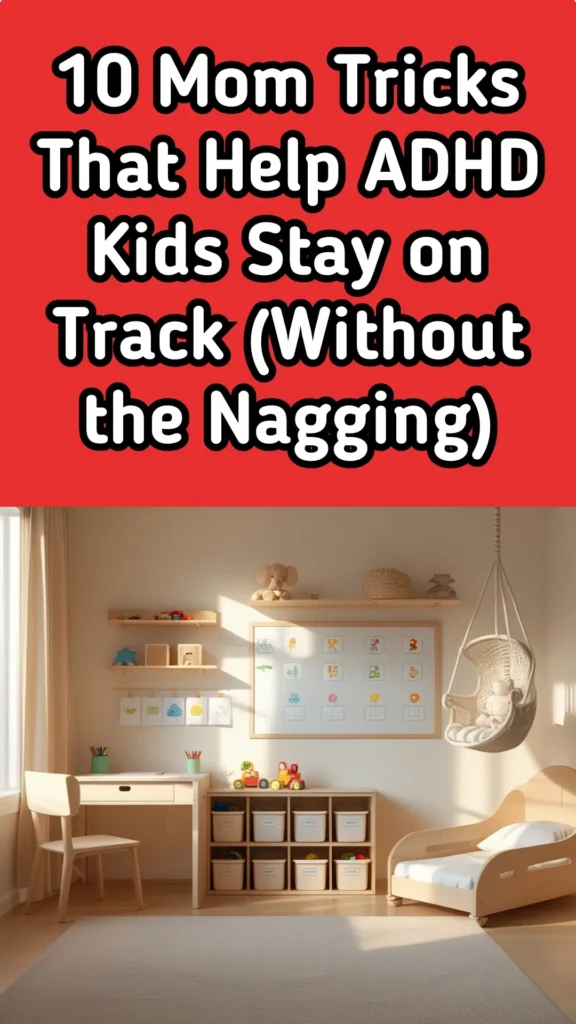Let’s be real for a second: raising a child with ADHD can feel like you’re herding caffeinated squirrels on roller skates.
Even on your best days, the constant reminders can drain your energy faster than your phone at 2%.
“Did you brush your teeth?”
“Where’s your homework?”
“Please, for the love of snacks, put on pants!”
And the guilt that comes with nagging or losing your cool? It’s brutal.
But here’s the truth: it doesn’t have to feel like this every single day.
Whether you’re a naturally organized mom, a beautifully chaotic one, or somewhere in between, the right kid-focused ADHD strategies can make a real difference.
These tricks are especially helpful if your child has ADHD. Bonus? If you happen to be wired a little differently too, they’ll still totally work for you.
Don’t forget to save this pin for later! You’ll want to come back to these strategies when you need them most.

Let’s walk through the tools that made my house calmer, my mornings smoother, and my kid feel way more in control. No yelling or endless chasing required.
1. Use One Visual Schedule That Stays Put
ADHD brains (kids especially) need structure they can see.
A simple visual daily routine chart hung in a central spot works better than reminders scattered everywhere. Think fridge or their bedroom wall.
It becomes a “neutral third party.” Not mom nagging, just the schedule saying what’s next.
Pro tip: Use pictures for younger kids or symbols if reading is tricky. The more ownership they have over checking it themselves, the less reminding you’ll need to do.
2. Prep the Night Before (Together)
Mornings are chaos magnets. So we flip it.
In the evening (after dinner but before the bedtime meltdowns), do a quick prep party together.
Lay out clothes. Pack backpacks. Line up shoes by the door.
It won’t be Pinterest-perfect, but your tomorrow self will want to high-five you. Plus, when kids help prep, they remember better and feel proud.
3. Keep Routines the Same (Even on Weekends)
Consistency is ADHD gold.
Try to keep wake-up, mealtimes, and bedtimes within a similar window. Even when you’re tempted to sleep in.
It helps regulate your child’s body and brain rhythms. This makes transitions smoother and meltdowns less frequent.
This one takes effort but pays off big time over the long haul.
4. Use a “Done Basket” Instead of Repeating Yourself
Ever get tired of saying “Did you finish your homework?” five hundred times?
Set up a simple “done basket” in a visible spot.
When homework, reading, chores, or even art projects are complete, they drop them in. You can glance at it and praise their effort without micromanaging.
Bonus: It helps them track their own progress, which builds confidence and independence.
5. Create an “Oops Kit” for Forgetfulness
ADHD kids forget stuff. All the time. And it’s usually at the worst moment.
Keep a labeled bin or basket by the door with backups of essentials.
Think comb, water bottle, socks, lunchbox, or permission slips.
This little kit has saved me more school trips than I can count.
6. Break Big Tasks Into “Mini Missions”
Telling your child to “clean your room” might as well be saying “build a rocket ship.” It’s overwhelming.
Instead, break it down:
- Pick up clothes off the floor
- Put toys in the bin
- Make the bed
Let them check off each task (on paper or aloud). ADHD brains thrive on visible progress, and it feels way more doable.
7. Let Movement Be Part of the Process
Stillness is not the goal. It’s okay (and helpful) if your child moves while doing tasks.
Let them bounce on a ball while reading. March between chores. Fidget with a stress toy while listening.
Movement can actually help ADHD brains focus better, not worse.
8. Use Timers That They Can See and Hear
Time blindness is real, especially for ADHD kids.
A visual timer (like a Time Timer or a big countdown clock) shows time passing in a way they can feel.
Use it for getting ready, brushing teeth, homework sprints, or screen-time limits.
It puts the pressure on the timer, not on you.
9. Build in Margin Time (a.k.a. “Transition Cushion”)
Your child probably doesn’t switch gears quickly.
Add buffer time between activities: 10 minutes to clean up before dinner, or a calm-down period between school and homework.
It gives their brain time to adjust and helps prevent meltdowns from feeling rushed.
10. Celebrate Wins (No Matter How Small)
Getting shoes on the first time? Win.
Bringing their homework home without reminders? Win.
Making it through a day without a meltdown? HUGE win.
Celebrate these. With a high-five, a sticker, a silly dance.
Positive reinforcement builds momentum and helps your child want to keep going.
Final Thoughts
Supporting a child with ADHD can feel like you’re constantly “on.” But when you shift from reacting to guiding, everything changes.
You’re not just managing symptoms. You’re building your child’s confidence, structure, and skills that will carry them for life.
And if you also happen to have ADHD, you might find these routines help both of you feel more grounded and less reactive. (There’s no one-size-fits-all, and that’s okay.)
Remember: You’re doing so much better than you think.
These little tweaks? They’re not about perfection. They’re about building a life that works for your family.
You’ve got this. 💛